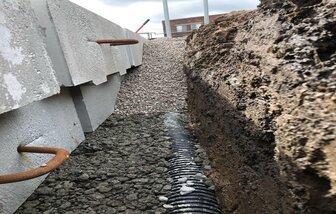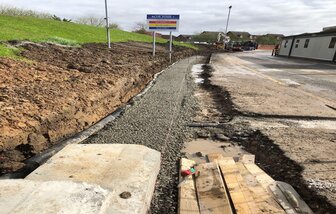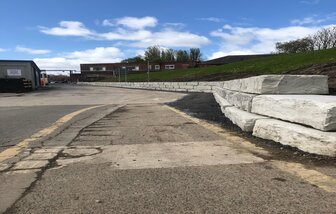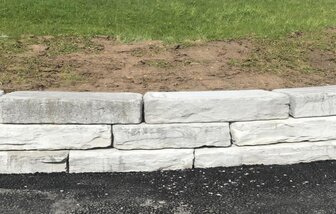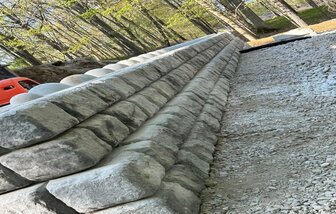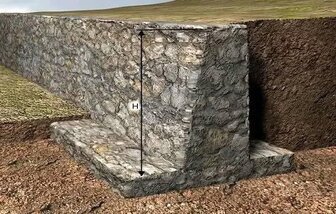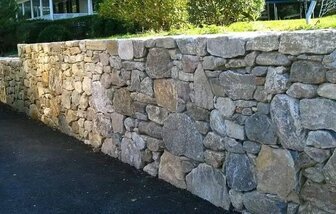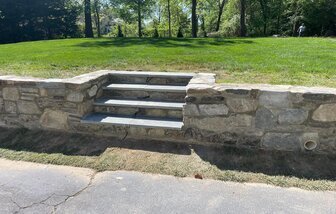Types of Retaining Walls
Discover the importance of retaining walls in the UK, used to stabilise sloped terrain, prevent soil erosion, and manage water runoff. Learn about different types including gravity, cantilever, sheet piling, anchored, gabion, and reinforced soil retaining walls, and understand their applications, materials, advantages, and challenges to make informed decisions for your construction or landscaping project.
Understanding the Different Types of Retaining Walls in the UK
Retaining walls are structural elements designed to resist the lateral pressure of soil or other materials. They play a crucial role in landscaping, construction, and civil engineering by providing stability to sloped terrain, preventing soil erosion, and managing water runoff.
In the context of the United Kingdom, retaining walls are particularly important due to the region’s varied topography and climatic conditions.
The primary purpose of a retaining wall is to hold back soil that would otherwise move downwards due to gravity. This is especially vital in areas with uneven terrain, where retaining walls can create level spaces for gardens, pathways, and building foundations. Additionally, they help in preventing landslides and managing rainwater drainage, thereby safeguarding properties and infrastructure.
Several factors influence the choice of retaining wall, making each project unique. Soil type is a significant consideration, as different soils exert varying levels of pressure on the wall.
For instance, clay soils tend to expand and contract with moisture changes, while sandy soils may shift and settle more easily. The slope of the land also affects the design and construction of the retaining wall, with steeper slopes requiring more robust solutions.
Furthermore, the intended use of the wall—whether for residential landscaping, commercial developments, or public infrastructure—will dictate its size, materials, and design complexity.
In the UK, the choice of retaining wall also hinges on regulatory standards and environmental considerations. Builders must comply with local building codes and environmental guidelines to ensure the wall’s longevity and sustainability.
By understanding these factors, one can make informed decisions about the most suitable type of retaining wall, thereby ensuring the structure’s effectiveness and durability.
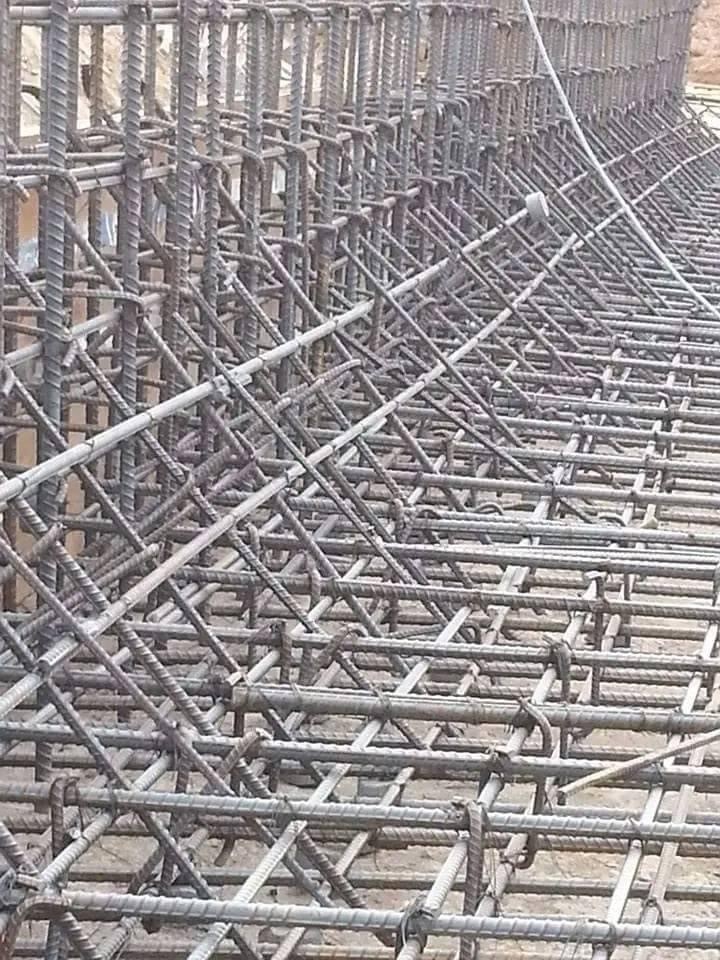
Gravity retaining walls are a fundamental type of structure that leverages its own weight to counteract the lateral pressure exerted by the soil it is designed to retain. These walls rely on their mass and stability to resist the forces pushing against them, making them a popular choice for various landscaping and construction projects across the UK.
The materials typically used in the construction of gravity retaining walls include concrete, stone, and brick. Concrete is often favored for its durability and ability to be molded into various shapes and forms, providing flexibility in design. Stone, on the other hand, offers a natural aesthetic that can blend seamlessly with the surrounding environment, making it an attractive option for residential and commercial landscapes. Brick is another common material, valued for its classic appearance and structural integrity.
One of the primary advantages of gravity retaining walls is their straightforward construction process. Due to their reliance on mass rather than anchors or reinforcements, these walls can be relatively easy and cost-effective to build, particularly for smaller projects. Additionally, the use of heavy materials such as concrete and stone ensures a long lifespan with minimal maintenance requirements.
However, gravity retaining walls also come with certain limitations. Their effectiveness is largely dependent on the height and mass of the wall, which can restrict their application in sites where space is limited or where exceptionally high walls are needed. In such cases, alternative retaining wall systems may be more suitable. Furthermore, the weight of the materials can pose logistical challenges during transportation and installation, potentially increasing the overall cost and complexity of the project.
In the UK, gravity retaining walls are best suited for projects that require moderate height and where ample space is available for construction. They are ideal for garden terraces, small retaining structures in residential areas, and other similar applications where their benefits can be fully realized without the constraints posed by their limitations.
Cantilever retaining walls are a prevalent type of retaining structure used to support soil laterally to prevent erosion and maintain levels on sloping grounds. These walls function on the principle of leverage, using a lever arm to balance the load and provide stability. The structure consists of a vertical stem and a horizontal base slab, which is further divided into a heel (the part under the retained material) and a toe (the part extending away from the retained material). This configuration allows the wall to leverage the weight of the retained soil to stabilize the structure against overturning and sliding.
The construction process typically involves excavating the site to the required depth, laying a compacted gravel base, and then pouring a reinforced concrete foundation. The vertical stem is then constructed, often using formwork to shape the concrete until it cures. Reinforced concrete is the material of choice due to its high strength and durability, as well as its ability to withstand the various stresses imposed by the retained soil and external factors such as groundwater pressure.
From an engineering perspective, cantilever retaining walls are designed based on several critical factors including soil type, load conditions, and environmental considerations. The design must ensure that the wall can resist overturning moments and sliding forces, while also accounting for the distribution of stress throughout the structure. Proper drainage behind the wall is also crucial to reduce hydrostatic pressure and prevent water-related issues.
Cantilever walls are particularly effective in the UK for medium-height applications, typically ranging from 3 to 6 meters. They are commonly used in residential, commercial, and infrastructure projects where space constraints necessitate a wall that provides effective soil retention without requiring extensive reinforcement.
However, there are benefits and drawbacks to consider. One significant advantage is their cost-effectiveness for medium-height walls and their relatively straightforward construction process. On the downside, they can be less suitable for very high walls or areas with poor soil conditions, where alternative retaining solutions might be more appropriate. Additionally, the design and construction require precise engineering to ensure long-term stability and performance.
Sheet piling retaining walls are a popular choice in the UK, particularly in scenarios where space is limited or the soil conditions are soft. This type of retaining wall is constructed by driving prefabricated sections of sheet materials into the ground. The materials commonly used for sheet piling include steel, vinyl, and sometimes wood. Each material offers unique benefits, making them suitable for specific applications.
Steel sheet piles are the most prevalent due to their strength and durability, capable of withstanding substantial pressures. Vinyl sheet piles, on the other hand, are resistant to corrosion and chemical reactions, making them an excellent choice for environments exposed to harsh elements. Wooden sheet piles, while less common, are utilized in temporary applications or where aesthetic considerations are paramount.
The installation process for sheet piling retaining walls involves driving the sheets into the ground using vibratory hammers or hydraulic presses. This technique is particularly advantageous in urban environments or along waterfronts, where space constraints and soft soil conditions can pose significant challenges. The interlocking nature of the sheets ensures a continuous barrier, providing effective soil retention and water resistance.
Sheet piling retaining walls are frequently used in the UK for a variety of applications. They are a common sight along riverbanks, canals, and coastal areas, where they help prevent erosion and manage water levels. In urban settings, these retaining walls are often employed in the construction of basements, underground parking structures, and other similar projects where excavation is required.
There are several advantages to using sheet piling retaining walls. Their relatively quick installation process can significantly reduce project timelines. The materials are also versatile and can be adapted to different environmental conditions. However, there are some drawbacks to consider. The cost of steel sheet piling can be high, and the installation process can be noisy and disruptive. Additionally, while vinyl and wood offer certain benefits, they may not provide the same level of strength and durability as steel.
Anchored retaining walls are a sophisticated solution widely adopted in various UK construction projects. These walls employ cables or rods, known as anchors, driven deep into the soil to provide additional support and stability. The role of these anchors is pivotal in ensuring that the retaining wall can withstand higher loads, making them particularly effective in scenarios where extra reinforcement is required.
There are primarily two types of anchors used in these retaining walls: mechanical anchors and grouted anchors. Mechanical anchors, also referred to as ground anchors, are driven into the soil and then expanded at the end to create a firm hold. This type of anchor is advantageous due to its immediate load-bearing capacity upon installation. In contrast, grouted anchors involve drilling a hole and then filling it with grout, which, upon hardening, forms a secure bond with the surrounding soil. Grouted anchors are often preferred in cases where a more substantial and permanent support is needed.
Anchored retaining walls are especially beneficial in challenging terrains and areas with loose or unstable soil. They are commonly employed in the construction of large-scale infrastructure projects, such as highways, bridges, and deep excavation sites. The primary strength of anchored walls lies in their ability to provide robust support without requiring massive wall structures, thus optimizing material usage and space.
However, the installation of anchored retaining walls does present certain challenges. The process of driving anchors deep into the soil can be complex and requires specialized equipment and expertise. Additionally, the long-term performance of these walls is heavily dependent on the quality of the soil and the correct installation of anchors. Poor soil conditions or improper installation can lead to reduced effectiveness and potential structural failures.
Despite these challenges, when designed and executed correctly, anchored retaining walls offer a reliable solution for numerous construction needs across the UK. Their ability to provide significant support in demanding situations makes them an invaluable asset in modern engineering and construction practices.
Gabion retaining walls are a popular choice in the UK for various landscaping and construction projects. These structures are constructed using wire mesh cages filled with rocks, stones, or other suitable materials. The mesh is typically made from galvanized steel, ensuring durability and resistance to corrosion. One of the notable features of gabion walls is their flexibility; they can be molded into various shapes and sizes, making them versatile for different applications.
The aesthetic appeal of gabion retaining walls is significant. The natural appearance of the rocks blends seamlessly with the surrounding environment, making them an attractive choice for landscaping purposes. Additionally, gabion walls provide excellent drainage capabilities. The gaps between the rocks allow water to pass through, reducing the risk of water pressure build-up behind the wall, which is a common issue with other types of retaining walls.
From an environmental perspective, gabion walls have several benefits. They can be constructed using locally sourced materials, reducing the carbon footprint associated with transportation. Moreover, the permeable nature of these walls supports the growth of vegetation, which can further enhance their integration into natural landscapes.
In terms of functionality, gabion retaining walls are widely used for erosion control and slope stabilization. They are particularly effective in areas prone to soil erosion, as the structure holds back the soil while allowing water to flow through. This makes them an ideal choice for riverbanks, coastal regions, and areas with heavy rainfall.
However, there are some disadvantages to consider. The initial installation of gabion walls can be labor-intensive, requiring precise placement of the rocks within the wire mesh. Over time, the wire mesh may also require maintenance or replacement, especially in harsh weather conditions. Additionally, while gabion walls are effective for moderate heights, they may not be suitable for very high retaining structures without additional reinforcement.
Overall, gabion retaining walls offer a balance of aesthetic appeal, functionality, and environmental benefits, making them a viable option for various applications in the UK.
Reinforced soil retaining walls represent a sophisticated engineering solution that effectively combines soil and various reinforcement materials to form a stable and durable structure. These walls are designed to enhance the shear strength and overall stability of the soil by integrating materials such as geogrids or geotextiles, which distribute loads more evenly and prevent soil displacement.
Geogrids are a common choice for soil reinforcement. These grid-like structures, typically made from polymers such as polypropylene, are embedded within the soil at specific intervals. Geogrids help to anchor the soil, providing lateral restraint and improving the wall’s load-bearing capacity. On the other hand, geotextiles, which are permeable fabrics, serve a dual purpose. They not only reinforce the soil but also facilitate drainage, reducing hydrostatic pressure behind the wall.
Construction techniques for reinforced soil retaining walls can vary. One popular method involves layering the reinforcement material between compacted soil layers. Each layer is carefully placed and compacted to ensure optimal strength and stability. This method is particularly advantageous as it allows for the construction of taller and more flexible structures compared to traditional retaining walls. Additionally, the use of local soil materials can often be incorporated, leading to cost savings and reduced environmental impact.
Reinforced soil retaining walls offer numerous benefits, making them a preferred choice in many UK applications. Their inherent flexibility allows them to accommodate ground movements without significant damage, which is crucial in areas prone to seismic activity or settlement. Moreover, the cost-effectiveness of these walls, due to the use of readily available materials and straightforward construction techniques, makes them an attractive option for various civil engineering projects.
In the UK, applications of reinforced soil retaining walls are widespread. They are commonly used in highway construction, railway embankments, and coastal defenses, where stability and durability are paramount. Their adaptability and performance make them a reliable choice for projects requiring robust and economical retaining solutions.
When embarking on a project that requires a retaining wall, the selection process is crucial to ensure the wall’s functionality and longevity. Various factors must be considered, including site conditions, budget constraints, aesthetic preferences, and long-term maintenance requirements. By evaluating these aspects, you can choose a retaining wall that aligns with your project’s specific needs.
Site conditions are a primary consideration. The soil type, slope gradient, and drainage requirements will heavily influence the type of retaining wall that is suitable. For instance, areas with clay soil may benefit from reinforced concrete walls due to their strength and durability. Conversely, sandy or loose soils might be better suited for gravity walls, which rely on their mass to resist pressure.
Budget constraints also play a significant role in the decision-making process. Some retaining walls, such as gabion walls, are cost-effective and quick to install, making them ideal for projects with limited financial resources. On the other hand, more complex structures like cantilevered walls may be more expensive but offer greater stability and longevity, justifying the investment for long-term projects.
Aesthetic preferences should not be overlooked, especially for projects where visual appeal is important. Timber retaining walls provide a natural, rustic look that blends seamlessly with garden landscapes. Brick and stone walls, often seen in UK heritage sites, offer a classic, timeless appearance. For a modern touch, concrete or steel walls may be more appropriate.
Long-term maintenance is another critical factor. Timber walls may require regular treatment to prevent rot and insect damage, whereas concrete and stone walls typically demand less upkeep. Assessing the maintenance requirements can help in choosing a retaining wall that fits your long-term management capabilities.
In the UK, numerous projects have successfully implemented different types of retaining walls. For example, the Eden Project in Cornwall utilizes gabion walls to support its biomes efficiently and cost-effectively. Meanwhile, the historic city of Bath features beautiful stone retaining walls that enhance its architectural heritage. These examples illustrate the diverse applications of retaining walls across various environments and project requirements.
By carefully considering site conditions, budget, aesthetics, and maintenance, you can select the most appropriate retaining wall for your project, ensuring both functionality and visual harmony.
Building Retaining Walls
Learn about retaining walls and their essential role in landscape design, offering both functional and aesthetic benefits. Discover various types of retaining walls, suitable materials, and important planning and design considerations to ensure stability and sustainability.
Foundation Depths For Retaining Walls
Discover the importance of retaining walls in landscaping and structural engineering. Learn about different types of retaining walls such as gravity walls, cantilever walls, sheet piling walls, and anchored walls. Follow a step-by-step guide
How to maintain Retaining Walls
Learn all about retaining walls, their importance in preventing soil erosion, and their applications in both residential and commercial settings in the UK. Discover the different types of retaining walls, how to inspect and maintain them, and the best practices
Retaining Wall Building Materials
Learn about different types of retaining walls and their applications, including concrete blocks, poured concrete, natural stone, brick, timber, and gabion baskets. Understand their benefits, limitations, and how to choose the right material for your project to ensure both functionality and aesthetic appeal.
What is a Retaining Wall?
Discover the essential aspects of retaining walls in landscape architecture. This comprehensive guide covers the types of retaining walls, materials used, and key design considerations. Learn about the construction process, regulations, and maintenance tips to ensure stability and longevity.
Types of Retaining Walls
Discover the importance of retaining walls in the UK, used to stabilise sloped terrain, prevent soil erosion, and manage water runoff. Learn about different types including gravity, cantilever, sheet piling, anchored, gabion, and reinforced soil retaining walls, and understand their applications, materials, advantages.
What is the purpose of Retaining Walls?
Discover the importance of retaining walls in landscaping and structural engineering. Learn about different types of retaining walls such as gravity walls, cantilever walls, sheet piling walls, and anchored walls.
Garden Retaining wall
Discover the essential role garden retaining walls play in landscaping, from erosion control to aesthetic enhancement. Learn about the benefits, popular materials, and design ideas to transform sloped gardens into functional and beautiful outdoor spaces.
Ready to start your project?
Let's Work Together
To get started, for general enquiries simply complete the form below. Provide us with your project details, and our team will review your requirements. We will then get back to you with a customised solution that fits your needs. Whether you have a small-scale project or a large-scale development, we have the expertise and resources to handle it.
If you prefer, you can also send us your project documents and any photographs to Price@totalregen.co.uk for pricing. We will carefully review your documents and provide you with a competitive quote.

